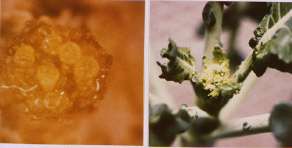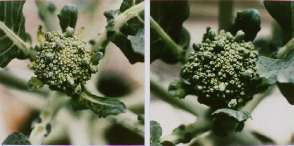The heat-sensitive stage of broccoli flower development
Thomas Björkman and Karen Pearson
(Presented as a poster at the 1995 meeting
of the American
Society for Horticultural Sciences in Montreal, Quebec.)
Greater depth is available in the publication
Björkman, T. and K.J. Pearson. 1998. High
temperature arrest of inflorescence development in broccoli (Brassica
oleracea
var. italica L.) Journal of Experimental Botany 49:101-106.
THE PROBLEM:
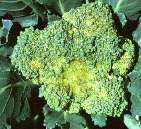 In many parts of the world, broccoli grows well but high temperatures
cause the heads to be distorted, making it a high-risk crop. High
temperatures
(>30° C) cause the heads to be rough, with uneven bud sizes. It
has been
difficult to screen for heat tolerance because the plant is sensitive
for
a relatively short period, so field observations are too variable for
effective
screening. Some heat-tolerant lines have been identified through
experience,
but no varieties have been bred by selecting specifically for
high-temperature
tolerance. This poster describes how to do that screening by
identifying
the time when the meristem is at the right stage to expose the plant to
high temperature.
In many parts of the world, broccoli grows well but high temperatures
cause the heads to be distorted, making it a high-risk crop. High
temperatures
(>30° C) cause the heads to be rough, with uneven bud sizes. It
has been
difficult to screen for heat tolerance because the plant is sensitive
for
a relatively short period, so field observations are too variable for
effective
screening. Some heat-tolerant lines have been identified through
experience,
but no varieties have been bred by selecting specifically for
high-temperature
tolerance. This poster describes how to do that screening by
identifying
the time when the meristem is at the right stage to expose the plant to
high temperature.
THE SOLUTION:
By identifying the exact developmental stage that is disrupted by excessive heat, the right time to stress candidate plants can be identified.
We found that the injury is an inhibition of the enlargement of bud primordia. Once the buds differentiate, they are no longer sensitive. The contrast between the delayed buds and the unaffected buds causes the uneven appearance.
If the stress is applied too early, during vegetative development, no injury will be seen. If the stress is applied too late, many buds are affected, but they are easily obscured by the older buds. Sensitive lines can easily be accepted if that happens
By varying when the stress was applied and dissecting matching plants to find the corresponding developmental stage we found the optimal time to apply the stress. We also identified subtle changes that can be observed without dissection. This method works even if one has no prior knowledge of the maturity of the lines to be tested or if the maturity is highly variable within the group.
Screening based on time after planting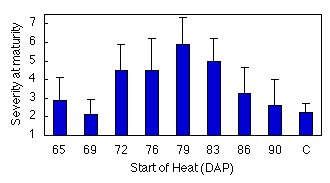
Heat injury to flower buds was greatest at 79 days after planting in this experiment, but there was great variability because the plants were not quite at the same developmental stage. The peak date also varied from one planting to another. Simply counting days from planting is not an efficient way to determine when to score for heat tolerance. With breeding lines that vary in maturity, it is also not possible to predict the best date in advance.
Screening based on developmental stage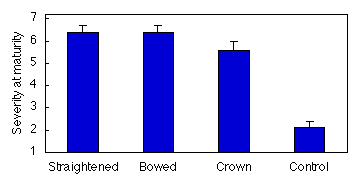
Heat injury to the flower buds was uniformly severe when the plants were stressed at the developmental stages Straightened and Bowed. These stages can be identified in individual plants, so no prior knowledge of the maturity date is needed, and the growing conditions do not have to be precisely reproduced. If the plants are stressed too early, during vegetative growth, there is little or no injury.
Later stress lets more buds escape injury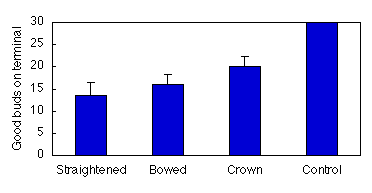
The number of buds that were past the sensitive stage when the stress began can be measured as the number of large buds in a whorl. As the head develops, more buds are past the sensitive stage. The controls had more than 30 good buds, but only the first 30 were counted. It is easiest to score the heads of the whorls only have 10 to 15 good buds.
How are the buds affected by heat?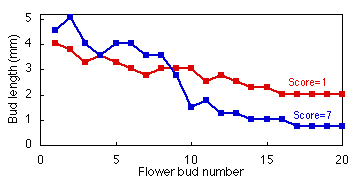
In this figure, one whorl of flower buds was sampled of a good head and a bad head. The size of the flower buds was measured, starting with the oldest bud and working inward. Within a whorl, the buds on the outside are the oldest, and they get younger and smaller towards the center. In a high-quality head, the bud size declines gradually and uniformly. The smallest buds are obscured by the larger, older buds, giving a very uniform appearance. Heat injured heads have normally-developed buds on the outer part of the whorls, but the central ones are smaller. Often there is an abrupt transition to the heat-injured buds. This pattern is expected if the buds enlarge normally after the heat stress, but is just postponed in the early bud primordia.
The external view of the transition to reproductive development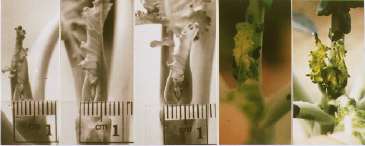
The width across the two most recently exposed petioles (tip width) is constant through most of vegetative growth (5 mm). When the apical meristem first undergoes the transition to flowering, two petioles are formed that are slightly straightened, and the tip width begins to increase (6 mm). Later petioles are progressively more bowed, through the Bowed stage (7 mm), the Crown stage (9 mm). Later the head is exposed (15 mm). These stages are 2 to 3 days apart under our growing conditions.
| Vegetative |  |
Only leaves are being formed, the leaf primordia fold over the apical meristem. |
|---|---|---|
| Straightened |  |
Transition to reproductive: The leaf primordia are shorter, and a small flat area can be seen at their base, which will become the first flowering branch. |
| Early reproductive |  |
The flowering branches can be seen in the axils of the leaf primordia. The lobes on the branch primordia turn into more branches. High temperatures at this stage delays flower-bud enlargement, but they continue to be formed. |
| Bowed | 1-mm head: Flowering branches continue to be produced, but no flower primordia are visible. | |
| Crown | 2-mm head. Many of the branch meristems have begun to produce flower buds instead of more branches. These buds will develop normally even at high temperature. |
Later development of head
The injury occurs very early in differentiation of the head, and
becomes
more visible as the head enlarges.
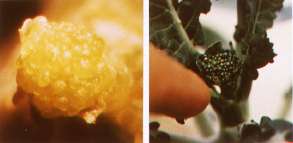 |
In normal development, the head at 2 mm (left) has relatively uniform primordia. These develop into evenly-sized flower buds (right). |
|---|---|
|
Heat-injured heads already show the damage at 2 mm, the crown stage (top right). A few large buds that escaped the injury continue to develop mormally, while the buds that were retarded by the heat are substantially smaller. The pattern looks the same as the head gets larger (top right and bottom). |
THE METHODS:
The early-maturing hybrid Galaxy was used in these experiments. Plants were grown in flats for 4 weeks, vernalized at 10C for a week, then planted into 5 pots and grown in the greenhouse. The resulting plants were smaller than field plants but developed normally. At designated times or growth stages, plants were moved into growth chambers for heat treatment at 35:25C (D/N) for one week. They were then returned to the greenhouse and grown until maturity when they were scored and buds were counted and their length measured. At the appropriate developmental stages the plants were also dissected for direct observation or fixed for electron microscopy.
Thanks to Dr. Michael H. Dickson for introducing us to this problem and for his continuing interest. This research was supported in part by Petoseed Inc. and Sakata Seed Co.

